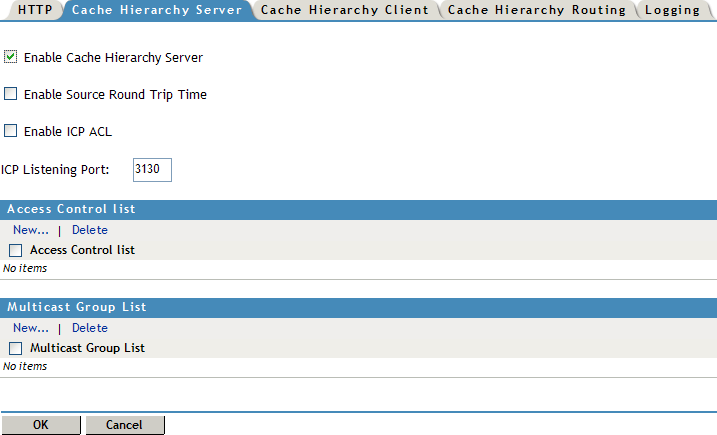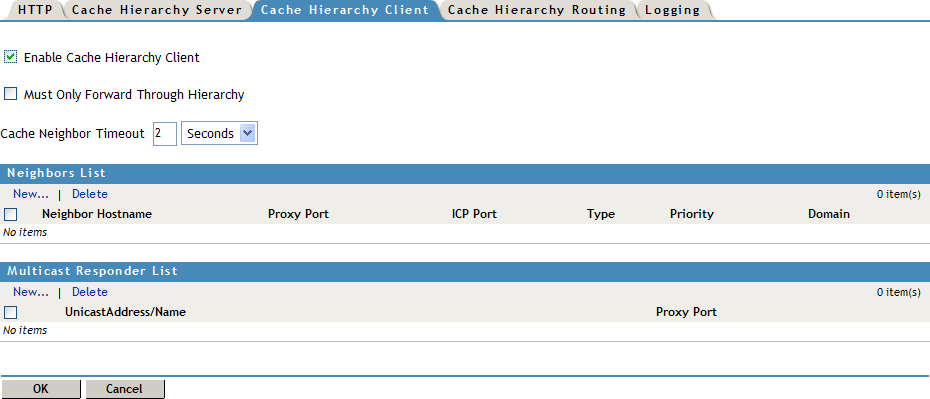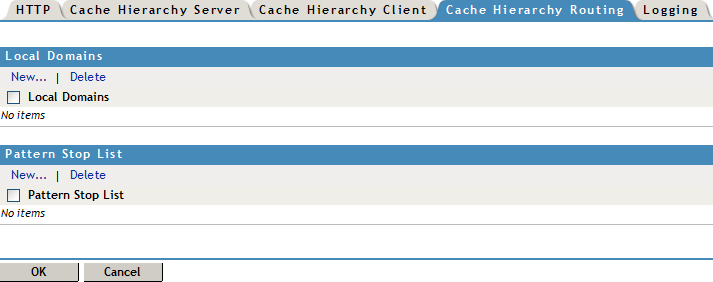3.1 Configuring Caching Hierarchies
If several proxy servers are serving the network, you can set up a hierarchy of proxy caches. If a proxy server does not find the requested page in its cache, it queries its peers and parents for the information. The queried peers and parents can then, in turn, query additional peers and parents for the requested information. The origin server is queried as the last resort.
The Novell BorderManager proxy server is compatible with other proxy servers on the Internet that are based on the Internet Cache Protocol (ICP). You can set up these proxy servers as peers (neighbors), parents, or both.
You can configure a CERN hierarchy, a cache hierarchy (ICP), or both. If both are configured, the cache hierarchy takes precedence and the CERN hierarchy is used as a backup. CERN hierarchies have only parents, whereas cache hierarchies have both parents and peers.
This section contains the following information on caching hierarchies:
3.1.1 Configuring Cache Hierarchy Server
To configure a cache hierarchy server:
-
Log in to iManager.
-
Select
-
Browse to and select the BorderManager server or container that you want to configure, then click .
-
Click in the section.
-
Select the tab.
-
Select to enable the cache hierarchy server.

-
Select to enable proxy to use the route that returns the shortest round-trip time. This parameter is used by the proxy to determine whether to send a request to the parent or to the origin server.
-
Select to enable the cache hierarchy or ICP access control on the server.
-
In the field, specify the UDP port on which the cache listens for queries from other caches.
-
consists of a list of hostnames or IP addresses that are used to verify whether proxies can send a request. The clients on this list are allowed to send a cache hierarchy request. You can perform one of the following actions in this section:
New: To add a new IP address, click , specify the hostname or IP address, then click .
Delete: To delete an IP address, select the check box next to the IP address, then click
-
consists of a list of multicast addresses on which the cache hierarchy server receives multicast cache hierarchy queries. You can perform one of the following actions in this section:
New: To configure a new multicast address, click , specify the Multicast IP address, then click .
Delete: To delete a multicast IP address, select the check box next the IP address, then click .
-
Click .
-
Click to save changes.
3.1.2 Configuring Cache Hierarchy Client
To configure a cache hierarchy client:
-
Log in to iManager.
-
Select
-
Browse to and select the BorderManager server or container that you want to configure, then click .
-
Click in the section.
-
Select the tab.
-
Select to enable the cache hierarchy server.

-
Select .
-
Select if you do not want the proxy server to retrieve the requested objects directly from the origin server.
-
In the value field, specify the number of seconds or minutes the proxy server waits for a response to a cache hierarchy request from another proxy server.
NOTE:Do not specify a value if you are configuring a CERN client.
-
The consists of one or more neighbors for the Neighbors List, with the following information specified:
Neighbor Hostname: Specifies the name of the nearest host server neighbor.
Proxy Port: Port number of the neighbor HTTP proxy.
ICP Port: Port number of the neighbor cache hierarchy client.
NOTE:Do not specify a value if you are configuring a CERN client.
Type: Specify the type of neighbor as peer, parent, or CERN. Select peer or parent if you are configuring a cache hierarchy client, or select if you are configuring a CERN client.
ICP Routing Priority: You can prioritize a set of parents or neighbors in a scale of 1 to 10. A cache hierarchy client chooses the fastest responding hierarchy cache with the highest priority to service a request. CERN uses pure priority routing without querying.
Domain Restriction: Specify domains that the cache hierarchy client will serve. Click to add new domains or click to delete existing domains.
To add a new neighbor, click and specify details in all the fields, then click .
To delete an existing neighbor, select the check box next to the neighbor that you want to delete, then click .
-
The is a list of all acceptable neighbors (unicast) that can respond to a multicast query. This list lets the cache hierarchy client verify that the responses are from a valid neighbor. You can perform one of the following actions in this section:
New: To add a new unicast, click , specify the unicast name or IP address, specify a proxy port, then click .
NOTE:Do not specify a value if you are configuring a CERN client.
Delete: To delete a unicast, select the check box next to Unicast Name/Address, then click .
-
Click .
-
Click to save changes.
3.1.3 Configuring Cache Hierarchy Routing
Use cache hierarchy routing when the parent cannot contact the origin server.
-
Log in to iManager.
-
Select
-
Browse to and select the BorderManager server or container that you want to configure, then click .
-
Click in the section.
-
Select the tab.

-
The consists of a list of local domain names for origin Web servers that are in close proximity. The proxy server prefers to query for a URL that it cannot resolve from these servers instead of from the cache hierarchy. You can perform one of the following actions in this section:
New: To add a new domain name to the Local Domain list, click , specify a domain name, then click .
Delete: To delete a domain, select the check box next to the domain name, then click .
-
The consists of a list of one or more stop patterns for which the cache must query the origin Web server directly. Specify patterns for which the delays caused by hierarchical caching are unacceptable, for example, static pages that change frequently. You can perform one of the following actions in this section:
New: To add a new pattern to the list, click , specify a pattern name, then click .
Delete: To delete a pattern, select the check box next to the pattern, then click .
-
Click .
-
Click to save changes.